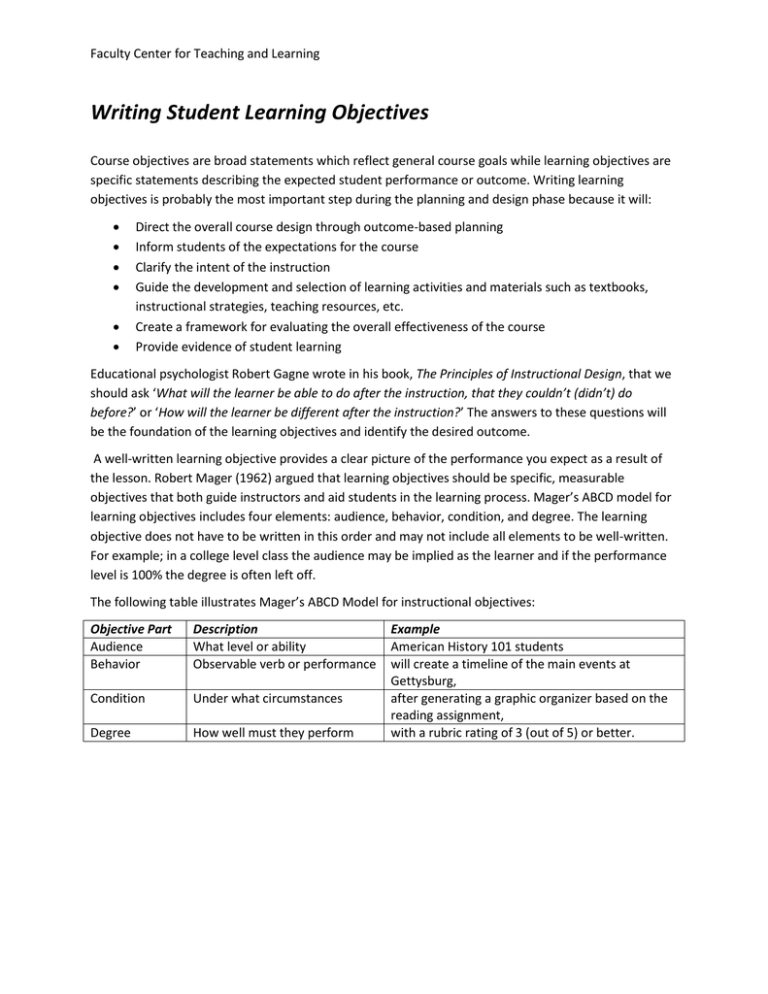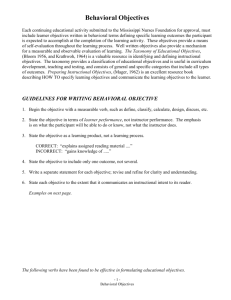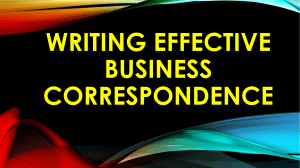Writing Student Learning Objectives
advertisement

Faculty Center for Teaching and Learning Writing Student Learning Objectives Course objectives are broad statements which reflect general course goals while learning objectives are specific statements describing the expected student performance or outcome. Writing learning objectives is probably the most important step during the planning and design phase because it will: Direct the overall course design through outcome-based planning Inform students of the expectations for the course Clarify the intent of the instruction Guide the development and selection of learning activities and materials such as textbooks, instructional strategies, teaching resources, etc. Create a framework for evaluating the overall effectiveness of the course Provide evidence of student learning Educational psychologist Robert Gagne wrote in his book, The Principles of Instructional Design, that we should ask ‘What will the learner be able to do after the instruction, that they couldn’t (didn’t) do before?’ or ‘How will the learner be different after the instruction?’ The answers to these questions will be the foundation of the learning objectives and identify the desired outcome. A well-written learning objective provides a clear picture of the performance you expect as a result of the lesson. Robert Mager (1962) argued that learning objectives should be specific, measurable objectives that both guide instructors and aid students in the learning process. Mager’s ABCD model for learning objectives includes four elements: audience, behavior, condition, and degree. The learning objective does not have to be written in this order and may not include all elements to be well-written. For example; in a college level class the audience may be implied as the learner and if the performance level is 100% the degree is often left off. The following table illustrates Mager’s ABCD Model for instructional objectives: Objective Part Audience Behavior Description What level or ability Observable verb or performance Condition Under what circumstances Degree How well must they perform Example American History 101 students will create a timeline of the main events at Gettysburg, after generating a graphic organizer based on the reading assignment, with a rubric rating of 3 (out of 5) or better. Faculty Center for Teaching and Learning Tips for Improving Learning Objectives: Learning objectives should be SMART – specific to a single outcome, measurable, acceptable to the instructor, realistic to achieve, and time-bound with a deadline. Avoid using language that is unclear or cannot be objectively measured. Use action verbs that describe what a student will be able to do after the lesson or activity. Include complex or higher-order learning objectives of what students should be able to demonstrate beyond knowledge or the memorization of facts and terminology. Use learning objectives as a basis for course development. Learning objectives should align with the instructional strategy and assessment methods for the course. The following table illustrates aligning the objective statement with learning activities and assessment. Learning Objective Learning Activities Assessment Provided with a four-part communication process model, students will be able to describe the main characteristics of effective communications for each part. Reading: Chapt. 1-3, PPT lectures and supplemental articles on Bb site. Self-evaluation: Mind Map – provide rubric Mind Mapping: students will create mind map of communication process and identify effective characteristics. Self/Peer evaluation: rate individual and team contribution for small group activity – provide rubric Small Group Project: assigned to one of the case studies outlined in the text, students will work in small groups to analyze the situation and provide possible solutions. They will then write a brief communication plan for the case study. Tool & Resources: Group pages, wiki site. Resources on writing Learning Objectives: Refer to these resource links for more information or contact an Instructional Designer in the FCTL for assistance with writing learning objectives for your course. Planning for Instruction – Writing Objectives http://itc.utk.edu/~bobannon/writing_objectives.html A Quick Guide to Writing Learning Objectives http://www.nwlink.com/~donclark/hrd/templates/objectivetool.html Writing Learning Objectives using Bloom’s Taxonomy http://www.ukcle.ac.uk/resources/personal-development-planning/table/


